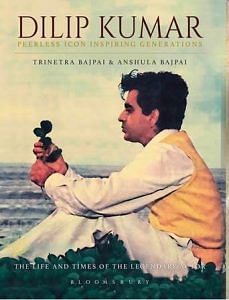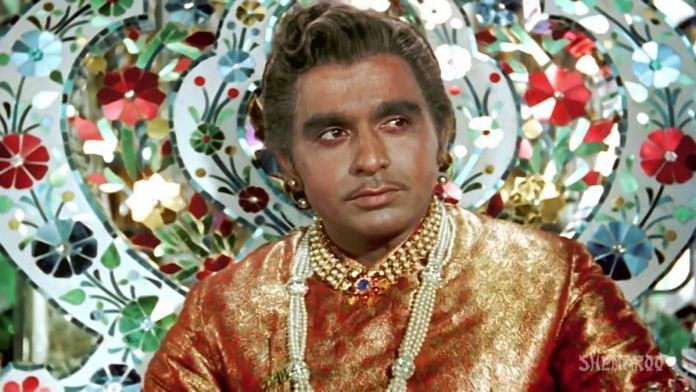The saga of the maverick dreamer K. Asif and the making of his cinematic extravaganza Mughal-E-Azam is a great story in itself. An Urdu scholar-dramatist Imtiyaz Ali Taj came across an old and long-untended grave on which was inscribed ‘Anarkali’ in 1920, which stirred his imagination to write a stage play titled ‘Anarkali’. The play was staged with great success and became extremely popular which prompted many filmmakers to attempt celluloid versions of the play. The first movie on it was made by the Great Eastern Corporation of India in the silent era titled The Loves of a Mughal Prince starring Sita Devi–Swarna Singh under the direction of Praful Kumar Ray. It was a huge success. Another version of the play, starring Sulochana (Ruby Myers–the big star of those times) and D. Billimoria under the direction of R.S. Choudhury came soon after but was a box- office disaster. Then came the talkie version in 1935 under Ardeshir Irani’s banner Imperial Film Company which was again directed by R.S. Choudhury, with music by Anna Saheb Mayenkar, which was a great box-office success.
K. Asif then was a cocky, domineering young man with an overwhelming ambition to make it big in films. He was the nephew of the then famous actor S. Nazir, who was not eager to be used as his nephew’s conduit into the film world. He, however, knew of Asif’s ambitions through actors Jeevan, the famous villain, and Prem Adib, a well-known mythological hero who owned a restaurant at Khodadad Circle (Dadar East) which was frequented by film aspirants including Asif. There, Asif used to boast with great confidence of making it big in films. Nazir set up a tailoring shop in the area for Asif and arranged very modest dwellings near Khodadad Circle. Asif at times shared his shop as living quarters with Naushad–who knew at that point in time as to what these legends-to-be would do together in future?
Nazir soon found out that Asif, who had put up a signboard at his shop declaring himself a ‘ladies tailor’, was more interested in flirting with his lady customers and in making time with a neighbouring tailor’s daughter. He was hardly interested in stitching clothes for the impatient clients he then had. Fearing for his own good reputation, Uncle Nazir hastily hushed up the matter, shut the tailoring shop and ushered his nephew as a directorial assistant into the film world–a world in which, ironically, the act of seduction is treated more casually than in tailoring. Within a few years (by 1944), the same cocky, overconfident youth had risen from the ranks of assistant to become a full-fledged director of Phool (1945).
Also read: ‘Tragedy King’ Dilip Kumar dies at 98 after prolonged illness
K. Asif also bowled Shiraz Ali over with his narration of the grand concept of Mughal-E-Azam which excited Shiraz Ali and he jumped at it. Asif wanted Dilip Kumar to be cast as Prince Salim but, at that time, Shiraz Ali thought that the legend-to-be was too skinny for the role. Eventually, Mughal-E-Azam was launched with the famous Chandra Mohan as Emperor Akbar, Nargis as Anarkali, Sapru as Prince Salim, famous Kathak dancer Sitara Devi (by that time she had become the second wife of Asif) as Bahar, Himalayawala as Durjan Singh and Durga Khote as Jodha Bai. Shooting started in 1946, but then came the partition of India when a large majority of Indian Muslims deciding to migrate to Pakistan without any delay. In this mass exodus, one of the earliest Muslims to leave for Pakistan, after selling his assets including the Famous Studios to J.B. Rungta, was Shiraz Ali Hakim and in the intervening period the famous Chandra Mohan also committed suicide. Grapevine also has it that the canned reels of the movie were burnt in the partition riots. No wonder the iconic film had to be was temporarily aborted.
The die-hard optimist in K. Asif took this setback in his stride. In between, he had developed a friendship with Dilip Kumar which continued to grow over years; his Kathak danseuse wife Sitara Devi also had a brother-sister relationship with Yusuf Saheb. Asif decided to graduate from director to producer and announced a film titled Jaanwar starring Suraiya and Dilip Kumar. Some shooting of the movie progressed but the film was shelved due to major differences that cropped up between the lead pair. Asif already had a friendship with Nargis who was the leading lady of the original Mughal-E-Azam as well as the backing of Dilip Kumar. K. Asif launched a star-studded Hulchul featuring Dilip Kumar, Nargis, Sitara Devi, Balraj Sahani, K.N. Singh, Geeta Nizami, Faizee and Cuckoo. Launched in 1948, the film was released in 1951 to become a moderate success at the box office. During the film’s making, Dilip Kumar and Nargis fell out with each other and Nargis vowed never to work with Dilip and Asif.
However, K. Asif had continued to dream of making a magnificent epic picture on the life and times of the Mughal Emperor Akbar and those days, he lived with the concept day in and day out. The folklore legend of Anarkali (in all probability, an unreal figment of a writer’s imagination) and the associated conflict between Emperor Akbar and Prince Salim catalysed by the dancer Anarkali continued to fascinate Asif. He revived Mughal- E-Azam and signed the famous actor Prithviraj Kapoor (also a theatre legend with a rich baritone voice) to play the title role of Emperor Akbar. Construction magnate and multi-millionaires Seth Shapoorji Mistry and Seth Pallonji Mistry were avid theatre enthusiasts and fans of Prithviraj Kapoor. Prithvirajji strongly recommended them to finance the grandiose Mughal-E-Azam and the Seths, quite fascinated by the subject, accepted. With the moneyed Shapoorji–Pallonji bankrolling the project, its finance no longer remained a problem.
K. Asif was very keen on Dilip Kumar playing Prince Salim and had taken the acceptance of his dear friend for granted. He was very surprised when Dilip showed his reluctance and expressed some trepidation on doing the role. Dilip Kumar thought that Prince Salim’s role may fall short of the expectations of his huge fan following since Prince Salim’s character was somewhat passive rather than active in the overall scheme of the narrative. He also felt that the real conflict was between King Akbar and Anarkali with Akbar being an overtly domineering factor. Added to that, no songs were to be picturised on the leading man as per the screenplay of the film. With all this in mind, Dilip initially said ‘no’ to Asif. But, we all know Asif by now–what Asif wanted, he got. And the impassioned manner in which he narrated the story, and the style and flamboyance with which he, as the director, had visualised he would present Prince Salim on screen, eventually led to a ‘yes’ from his friend. But the fact remains that Prince Salim was a total departure from any role essayed by Dilip Kumar before. A character in the genre of the classical historical drama had not been attempted by any of his contemporaries, neither has it been attempted with as much success by any of the present generation of actors.
Also read: Dilip Kumar as ‘Pyaasa’ hero is what Guru Dutt wanted. But first day of shoot changed it all
Durga Khote (the original choice) was retained to play the role of Empress Jodha Bai. Actor Ajeet, whose career as a leading man was on the wane, was cast in the important role of Durjan Singh, with character actor-producer-director Kumar Mijjan as the maverick sculptor Sangtarash. Murad was given the role of Raja Man Singh. The coveted role of Bahar went to actress Nigar Sultana who was to be the third wife of K. Asif in the time to come. By now, Asif had hired two sound stages in Mohan Studios at Andheri (which eventually became the K. Asif Studio) and construction of the huge sets, artefacts and paraphernalia for Mughal-E-Azam began.
Asif also worked very hard on polishing the final script in association with his team of writers, all Urdu-language literary heavyweights–Kamaal Amrohi, Ehsaan Rizvi, Wajahat Mirza, Amanullah Khan (father of later day actress Zeenat Aman) and their associates. The screenplay, scenic progression and the dialogue were meticulously crafted to perfection. Asif’s highly competent senior production manager S.T. Zaidi had a major contribution in the perfectMughal-E-Azam became and has perennially remained a timeless classic. The pulse of the Mughal era had been touched with astounding acumen. The splendour of the bygone era has never been recreated with such eye-filling sumptuousness and that too, largely in black and white. Madhubala literally lived her role, captivating all with her seamless charm and the delicate rendering of the character of the tormented kaneez (bestowed with the title of Anarkali) so hopelessly in love with Prince Salim.
Dilip Kumar turned in a rare depiction, cast almost as it were in a Shakespearean mould. He rendered his dialogue with a crystalline diction and majesty. It was evident, right from the first to the closing frames, that he owned the character. An exercise outside the ambit of his personality, his performance in Mughal-E-Azam should rank with the best that he or for that matter anyone else has tried in the realm of the historical sagas in Indian cinema.
 This excerpt from ‘Dilip Kumar: Peerless Icon Inspiring Generations’ by Trinetra Bajpai and Anshula Bajpai has been published with permission from Bloomsbury India.
This excerpt from ‘Dilip Kumar: Peerless Icon Inspiring Generations’ by Trinetra Bajpai and Anshula Bajpai has been published with permission from Bloomsbury India.



